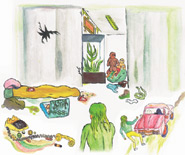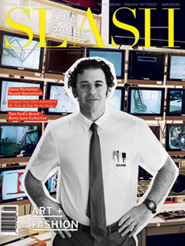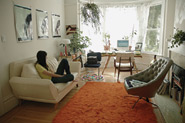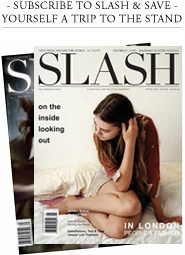
Monochromatic Canvas, Latex & Styrofoam
Photography by Zen Sekizawa Text by Helen Chang
Zenita Komad’s work is mysterious and impolite, with something
that prickles. When we first met, she said she subsisted only on rice,
white pellets not unlike the beads she uses to fill the tentacled roots
breaching her canvases. Given her slight frame and skin as pale as a
Victorian consumptive’s, it wasn’t hard to believe. Then one day she
appeared with a small mountain of exquisite fig cookies. I hesitated
before taking one, and then decided they were actually store-bought and
hadn’t come out of her kitchen, which was rather filled with paint and
brushes than with food.
As tantalizing as her paintings are, it’s the extreme polarization of her imagination, the marrying of feast and famine, that serves as an astringent in her work, which otherwise might come off as too self-conscious. In one of her most striking three-dimensional sculpture paintings, Ranking, roots resembling cilia-like fingers and limbs tumble out of the canvas into the room, as if to announce their secret obsession to emancipate themselves from the wall. Originally a stage designer, Komad began the gravy-green piece, one in a series of monochrome object paintings, as a self-portrait. What if human beings had roots like trees, she asks. In another sculpture painting, Use Your Brain, Maria Callas’ mime-like white face floats in a black background, her flawless features set in a modest smile. Her gaze turns upwards: She is being felled by a comic crimson arrow which plunges into the canvas where her frontal lobe begins and casts a cryptic shadow across her face. Black drips and red sprinkles surface on her brow and cheekbone. The arrow is later encountered as a sculpted artifact touching the wall, positioned as if ready to locate the next subject of its violent focus in real space.
Ranging from painting to film, operas and installations, and most recently, to sculptural paintings, Komad’s work is a riot of styles and artists (in the vein of): Robert Rauschenberg, Ilya Kabakov, Louise Bourgeois and Jeff Koons—the latter for how he confronts viewers in an ironic, yet utterly sincere way. Her work is also haunted by the Viennese Actionists. There are traces of their theatricality, their cathartic trauma, but hardly any of the pain or bitterness.
Instead, she prefers a lighter touch—a [Paulo] Coelhoian approach to asking questions of consciousness, desire and spirituality in a way that is personally and universally revelatory. In liebe auch, she painted, “Wissen ist eine höchst komplizierterte, liebe auch.” (Knowledge is the most complicated love also. Or, read another way, knowledge is a most complicated love, also.) These bold statements often evince a kern of hesitation. As if on the search for absolute truth, during which she tests her finds on canvas and holds them to light, she realizes they cannot be valid.
Pages: 1 2















